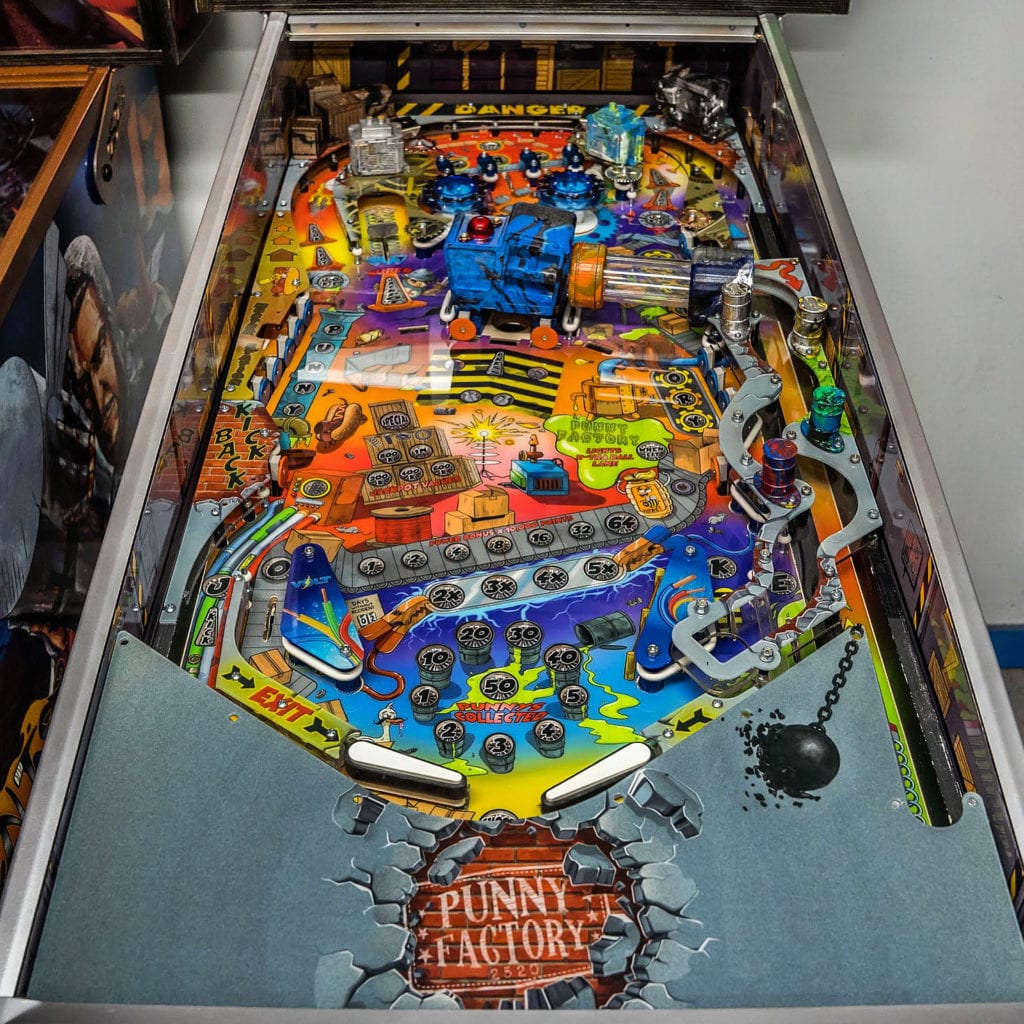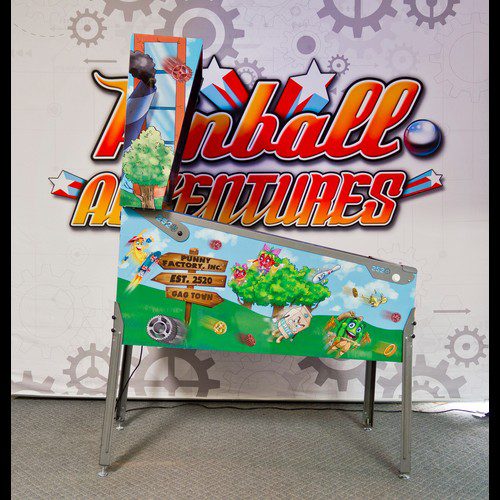So How Do Pinball Machines Really Work?
To understand how pinball machines work we got to go back to the beginning, since the first true pinball game, Humpty Dumpty, was released by Gottlieb in 1947, people the world over have had an obsession with making a little silver ball jump all over a table, hitting targets and flying up ramps along the way. In the past half-decade, countless technologies have been added to pinball tables to attract players, yet the goals of the game remain the same: score points and keep the pinball from going down the drain.
Get The Ball Rollin’
When you first approach a modern pinball machine, you are met with an intricate weaving of electronic and mechanical parts, all designed to create a game in which you are challenged to score points without losing the ball or tilting the game.
The main components of the game are the pinball and the flippers. The flippers are usually located at the bottom of the playfield, directly above the drain. One of the purposes of the flippers is to keep the pinball from falling down. The other purpose is to shoot the ball up the table toward the bumpers and ramps in order to score points -occasionally, extra flippers are placed farther up on the table for this purpose. The flippers are controlled with two buttons, one on either side of the machine, about an inch below the table’s top glass. The left button controls any and all flippers on the left side of the table, and the right button controls the ones on the right side. Source
Backbox
The backbox portion of the table serves two purposes: to hold the main electronics of the game and to attract players with a decorative piece of art located on the backglass. The electromechanical bumpers and flippers found on the table are all tied into the main controller board located behind the backglass. Located on this board, like on a computer motherboard, is a ROM chip that contains all the information needed to play the game.
The wiring that runs from the controller board to the rest of the machine is massive, usually consisting of over a half-mile of wire. The wires carry commands back and forth between the main board and the flippers, bumpers, targets and ramps.
There are usually two other pieces of electronics contained in the backbox. A dot-matrix display board, usually either 128×32 or 192×64 pixels in dimension, is located at the base of the backglass. This display is used to relay information to the player, such as the score and hints about how to increase the score and possibly get a free game. Also, since the early 1990s, a speaker has been located on either side of the dot-matrix display. Pinball sounds are now digital and have grown to include full musical scores to accompany game play.
The backbox the second purpose is to attract the players. The backglass art is carefully crafted to draw the player to a certain machine over any other in the arcade. Usually done by a professional artist, some original back glass paintings have been sold to collectors for thousands of dollars. Along with the art, the dot-matrix display is also used to attract players. Elaborate animations are created to run on the display in conjunction with the theme of the machine.

The Playfield
The pinball playfield itself is usually made of a wood base coated with several layers of paint and finish. Here’s how pinball machines work,The playfield is inclined at a 6-to-7-degree angle toward the player, creating a hill on which the ball is influenced by gravity just enough to speed it along though obstacles. The bumpers, ramps and flippers are all mounted onto the playfield physically with screws and glue. All of these obstacles and targets are then wired into the main controller board in the backglass area so that the computer can tell where the ball is at any given time and react accordingly by giving points or activating special features.
When you first put your money in the coin slot, the coin acceptor tells the computer that it has received a credit. Once you have deposited the proper number of credits, the display flashes “Press Start.” The start button is a about the size of the flipper buttons and is usually located on the front-left side of the machine.
Once the start button is pressed, a ball from the trough is placed into the launch lane in front of the plunger. On some machines, you still have to pull the plunger back and let it go to launch the ball into play. On many newer machines, however, there is simply a button or other themed device that you activate to launch the ball. When activated, a solenoid behind the ball is triggered, kicking the ball into play. The solenoid is also wired into the computer so that if a ball gets lost on the table or the player receives a multiball award, another ball can be launched onto the playfield with no action required by the player.

JACKPOT!
Scoring in pinball games is a mystery to most amateur pinball players, whose basic goal is simply to keep the ball from going down the drain. The pinball expert however, is after much more.
Your current score is kept on the dot matrix display located at the base on the backglass. This display is the center point of all scoring options and profiles. In most newer games, this display guides you, though animations or words, as to which ramps to shoot or which targets to hit in order to score the most points.
The experienced pinball player is able to score the most points through combination shots. These shots consist of a specific sequence of moves that activates a jackpot or some other scoring mechanism — the specifics vary with the different themes of the pinball machines.
In the High Roller pinball machine, a particular combination shot activates a poker-like game that provides the opportunity to score more points. The first objective is to hit the four poker targets. Once all four targets are hit, you are prompted both on the display and by a lighted sign on the table to shoot the right ramp to play poker. In playing an interactive poker game on the display, you have the opportunity to win millions of points.
The poker game is only one of the games on the table, and each one is a complete game unto itself. When all the games are played and won, a special mode called “Casino Frenzy” is activated. Known as a “Wizard Award” in pinball circles, the big points are scored in this mode. Four balls are put into play, and the point values for all the targets increase. Depending on which targets you hit during this multi-ball period, you may win the Super Jackpot, which is the largest single allotment of points you can win during the game.
All pinball games use a similar method in awarding points, with slight variations. Some machines may only have one or two smaller games, with the emphasis on keeping the ball in play; others, like High Roller, put the emphasis on making specific shots in a specific sequence. Hitting individual bumpers and targets scores some points, but without making combination shots you won’t be making the high-score list.
Replay
Before your last ball, you usually see a screen flash up on the display saying something like “Replay Value: 30 million.” This means that if you reach this point total, you receive a free game. Free games are few and far between — most modern machines are set so that only about the top 10 percent of scores is above the replay-value score. One clue that you’ve won a free game is a loud noise that sounds like something banging against the side of the pinball machine from inside. This is just a signal to you (and to everyone around you) that you get to play again. After you win your first replay, the machine sets the next replay value to 150 percent of the first in order to make it harder for you to keep playing for free.
Match
One other way to win a free game is by simple luck. All pinball machines have a match feature built in, whereby a multiple of 10 (00 though 90) is selected at random. If these digits match the last two digits of your score, you have “matched” and you win a free game! On most machines, your chance of “matching” is seven percent or less.
Tilt!
One pinball component that most players have come into contact with is the tilt sensor. The tilt sensor is there to make sure players don’t cheat – at least not too much, anyway. By shaking the machine, a player is able to influence how the ball travels down the playfield and score more points in the process. A skilled player knows exactly how much he is able to shake the machine without setting off the tilt sensor. The sensor consists of a metal ring with a cone-shaped pendulum bob hanging through the center of it. Normally, the bob hangs so that none of it is touching the ring.

As the machine is shaken, the bob comes closer to the edges of the conductive ring. Once the bob touches the ring, a current is transferred and a tilt is registered. Depending on the machine, you might lose your ball, or you might only get warned. Most new machines give you two warnings before all the flippers stop working and your ball goes down the drain.
There are also devices that look for slam tilts. A slam tilt is a heavy abuse of the game, usually in the form of someone picking the machine up or kicking the front end very hard. Registering one of these immediately ends the game. Source
Thanks for reading! Did you learn how pinball machines really work?
Pinball Adventures is a North American manufacturing company producing fresh and unique Pinball machines, as well as a series of Pinball related regalia. Wall original artwork and created to the highest standards, our machines spark the same joy we found as gamers when we rolled our first quarter into that coin slot so many years ago. Stemming from a lifelong passion, Pinball Adventures is created by gamers, for gamers. We strive to bring high quality, innovative, and captivating experiences for all to enjoy.
Visit our website at pinballadventures.com.
Pinball, Pinball Adventures, Pinball Buzz, Pinball, Pinside, History of Pinball, Pinball News, Pinball Updates, Origin of Pinball, How Do Pinball Machines Work



